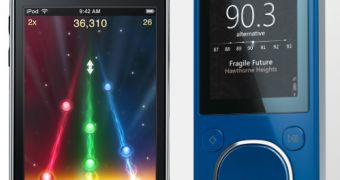Microsoft and Apple are making a tradition of releasing new digital media player product line-ups, along with firmware and service upgrades in tandem on an annual basis. On September 8, 2008, Microsoft unveiled Zune 3.0, an evolution touted to crank up a notch the process of accessing digital music via the Redmond giant's device. A day later, on September 9, Apple released the second generation iPod touch and the fourth generation of iPod nano, claiming to deliver the “funnest iPod ever”. The truth? Both the Redmond and Cupertino companies delivered very little on top of the 2007 line-up of products, software and services.
2007 marked a giant leap for Apple in terms of the evolution of the iPod and the product's ecosystem. With the September 9 announcements, the Cupertino-based hardware company managed to offer consumers only cosmetic, superficial modifications to what was already available, with no major innovations. This does not mean that Apple is not still ahead of the other players on the digital media players market, including Microsoft. This aspect is evident in nothing more than the market share owned by Apple with the iPod, over 73% just in the U.S.
Apple revealed that “the iPod is the world’s most popular family of digital music players with over 160 million sold. Apple’s incredible new lineup includes the iPod shuffle in four vivid new colors starting at just $49; the iPod classic in one slimline model with 50 percent more capacity for the same great price - 120GB of storage for just $249; the fourth generation iPod nano featuring a gorgeous curved aluminum and curved glass enclosure, in nine vibrant colors starting at $149; and the second generation iPod touch now starting at just $229.”
What is sad for Microsoft is that the Redmond company, even in a year when Apple failed to deliver any major iPod-innovation, introduced just a modest update to Zune 2.0. And modest is not so much a euphemism as a criticism, considering that Microsoft has yet to catch up with Apple, and that it cannot afford anything short of the fastest technological pace possible, but certainly not a move to a 3.0 generation which resembles a stagnation.
Apple has indeed softened the rough edges of iPod touch and equipped the new devices with volume control buttons, built-in speakers, as well as accelerometer sensors. At the same time, the Cupertino-based hardware company re-styled iPod nano, dropping the bulky design offered at the end of 2007. But the iPod classic is nothing more than the same device it was last year, now with a bigger hard drive.
“iPod touch is the funnest iPod we’ve ever created,” claimed Steve Jobs, Apple’s CEO. “Users can listen to millions of songs, watch thousands of Hollywood movies and now, thanks to the App Store, download and play hundreds of great games on their iPod touch.”
Just like Apple, Microsoft found itself at an all time low in terms of Zune innovations. Furthermore, the Redmond company is adopting a strategy in which the device is nothing more than an appendix of the Zune service itself, and not the focal point by any measure. Robert J. Bach, President, Entertainment & Devices Division, indicated to SeattlePI that Microsoft is leaning hard on the software and service aspect of the Zune product and less on the actual hardware. Furthermore, Zune is, of course, only a small part of the Connected Entertainment puzzle built by Microsoft, stretching to include devices such as the Xbox and Windows Mobile phones. In fact, the biggest announcement for Zune 3.0 was the Buy from FM feature.
“There’s a reason we put in FM Radio and wireless capabilities in every device and Zune 3.0 delivers something that I am sure you’ll be impressed with, Buy from FM. Second to friends, terrestrial radio is a major way people find now music. 50% of Zune owners use FM radio on a regular basis. Now when you hear a song on a radio station that transmits with RDS or RT+ data feeds, you’ll be able to tag that song and purchase it,” stated Cesar Menendez, from the Zune team. “Another feature that will take advantage of wireless capabilities is the ability to browse, stream, buy and download from Zune Marketplace on the device. When you are connected to a wireless network, you can check out the top hits, newest release or even search for your favorite artist with the new search function.”
While the Zune 3.0 and new iPod releases indeed came almost concomitantly, Microsoft and Apple also synchronized the prices of the products. Come September 16, Zune will be available in five variants 120 GB: $249.99; 80 GB: $229.99; 16 GB: $199.00; 8 GB: $149.99 and 4 GB: $129.99. Apple will sell iPod Shuffle 1 GB: $49; 2 GB: $69; iPod nano 8 GB: $149; 16 GB: $199; iPod touch 8 GB: $229; 16 GB: $299; 32 GB $399 and iPod Classic: 120 GB: $249.

 14 DAY TRIAL //
14 DAY TRIAL //